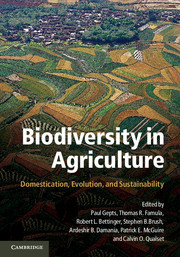Book contents
- Frontmatter
- Contents
- Tables
- Figures
- Foreword
- Contributors
- Acknowledgments
- Introduction: The Domestication of Plants and Animals: Ten Unanswered Questions
- 1 The Local Origins of Domestication
- Section I Early Steps in Agricultural Domestication
- Section II Domestication of Animals and Impacts on Humans
- Section III Issues in Plant Domestication
- Section IV Traditional Management of Biodiversity
- Section V Uses of Biodiversity and New and Future Domestications
- 22 Participatory Domestication of Indigenous Fruit and Nut Trees: New Crops for Sustainable Agriculture in Developing Countries
- 23 The Introduction and Dispersal of Vitis vinifera into California: A Case Study of the Interaction of People, Plants, Economics, and Environment
- 24 Genetic Resources of Yeast and Other Micro-Organisms
- 25 Biodiversity of Native Bees and Crop Pollination with Emphasis on California
- 26 Aquaculture, the Next Wave of Domestication
- 27 Genetic Sustainability and Biodiversity: Challenges to the California Dairy Industry
- Index
- References
26 - Aquaculture, the Next Wave of Domestication
Published online by Cambridge University Press: 05 June 2012
- Frontmatter
- Contents
- Tables
- Figures
- Foreword
- Contributors
- Acknowledgments
- Introduction: The Domestication of Plants and Animals: Ten Unanswered Questions
- 1 The Local Origins of Domestication
- Section I Early Steps in Agricultural Domestication
- Section II Domestication of Animals and Impacts on Humans
- Section III Issues in Plant Domestication
- Section IV Traditional Management of Biodiversity
- Section V Uses of Biodiversity and New and Future Domestications
- 22 Participatory Domestication of Indigenous Fruit and Nut Trees: New Crops for Sustainable Agriculture in Developing Countries
- 23 The Introduction and Dispersal of Vitis vinifera into California: A Case Study of the Interaction of People, Plants, Economics, and Environment
- 24 Genetic Resources of Yeast and Other Micro-Organisms
- 25 Biodiversity of Native Bees and Crop Pollination with Emphasis on California
- 26 Aquaculture, the Next Wave of Domestication
- 27 Genetic Sustainability and Biodiversity: Challenges to the California Dairy Industry
- Index
- References
Summary
Aquaculture, the fastest growing sector of global food production, accounts for nearly 40% of aquatic production and will soon surpass capture fisheries, forecast to collapse by mid-century. While “animals are not essential” (Harlan, 1995), fish and shellfish make up a substantial portion of human diet, supplying protein and nutrients essential for human development and health. Aquaculture relies largely on natural reproduction or hatchery propagation of wild stocks and boasts few domesticated species (common carp, rainbow trout, Atlantic salmon). There are enormous challenges in conserving while utilizing the planet's imperiled aquatic biodiversity. Overfishing, introduction of nonnative species, adverse interaction of wild and farmed stocks, and ocean warming and acidification are risks to aquatic genetic resources. The high fecundity of marine fish and shellfish, in particular, creates the risk that release or escape of large, hatchery-propagated families will dilute the genetic diversity of wild populations. Research on developing and improving domesticated stocks for aquaculture should have high priority alongside research on reducing or eliminating interactions with wild populations. There is an opportunity that Jack Harlan would have relished, to document the domestication process in aquaculture, though its course in the human-dominated world is likely to differ markedly from that of plant and animal domestication.
Aquaculture
How inappropriate to call this planet Earth, when clearly it is Ocean. (Arthur C. Clarke)
- Type
- Chapter
- Information
- Biodiversity in AgricultureDomestication, Evolution, and Sustainability, pp. 538 - 548Publisher: Cambridge University PressPrint publication year: 2012
References
- 5
- Cited by



